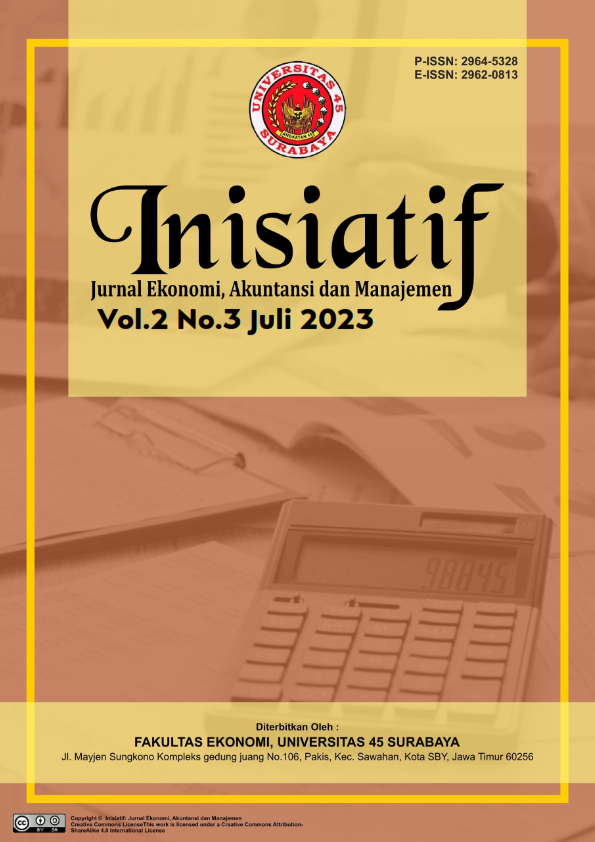Analisis Faktor Determinan Financial Distress (Studi Empiris Pada Perusahaan Go Public di Indonesia)
DOI:
https://doi.org/10.30640/inisiatif.v2i3.1124Keywords:
Financial Distress, ROA, CSR DisclosureAbstract
This study aims to determine the effect of return on assets (ROA) and CSR disclosure on financial distress in trading sector companies registered on the Indonesian Stock Exchange during 2020-2021. The research method uses quantitative methods. The population in this study are trading sector companies listed on the Indonesian Stock Exchange. Based on the sample selection criteria, a sample of 82 companies was obtained. The data analysis technique used is descriptive statistical analysis, testing the entire model, coefficient of determination, model feasibility test, simultaneous model significance test, and partial model significance test. The results of the study show that ROA have an effect on financial distress. Meanwhile, CSR disclosures proxied by managerial ownership and the proportion of independent commissioners have no effect on financial distress. The coefficient of determination of 58,6 percent indicates the ability of ROA and CSR disclosure to explain changes in financial distress of 58,6 percent, while the remaining 41,4 percent is explained by other factors.
References
Agustini, N. W., & Wirawati, N. G. P. (2019). Pengaruh Rasio Keuangan Pada Financial Distress Perusahaan Ritel Yang Terdaftar di Bursa Efek Indonesia (BEI). E-Jurnal Akuntansi, 26(1), 251–280.
Al-Hadi, A., Chatterjee, B., Yaftian, A., Taylor, G., & Monzur Hasan, M. (2019). Corporate social responsibility performance, financial distress and firm life cycle: evidence from Australia. Accounting and Finance, 59(2), 961–989. https://doi.org/10.1111/acfi.12277
Altman, E. I., & Hotchkiss, E. (2005). Corporate Financial Distress and Bankruptcy. Corporate Financial Distress and Bankruptcy. https://doi.org/10.1002/9781118267806
Attig, N., El Ghoul, S., Guedhami, O., & Suh, J. (2013). Corporate Social Responsibility and Credit Ratings. Journal of Business Ethics, 117(4), 679–694.
CNBC Indonesia. (2020). Emiten dari Sektor Ini Paling Sengsara Hadapi Efek Covid-19. Www.Cnbcindonesia.Com. www.cnbcindonesia.com
CNN Indonesia. (2020). BPS: 82 Persen Pendapatan Perusahaan Merosot di Era Covid-19. Www.Cnnindonesia.Com. www.cnnindonesia.com
Danilov, K. (2014). Corporate Bankruptcy: Assessment, Analysis and Prediction of Financial Distress, Insolvency, and Failure. SSRN Electronic Journal. https://doi.org/10.2139/ssrn.2467580
FCGI. (2001). Corporate Governance : Tata Kelola Perusahaan.
Godfrey. (2005). The relationship between corporate philanthropy and shareholder wealth: A risk management perspective. Academy of Management Review, 30(4), 777–798. https://doi.org/https://doi.org/10.5465/AMR.2005.18378878
Gupta, K., & Krishnamurti, C. (2016). Does corporate social responsibility engagement benefit distressed firms? The role of moral and exchange capital. Pacific Basin Finance Journal, 50, 249–262.
Jensen, M. C., & Meckling, W. H. (1976). Theroy of The Firm: Managerial Behavior, Agency Cost, and Ownership Structure,. Jurnal of Financial Economics, 3(4).
Mesak, D., & Sukartha, I. M. (2019). Financial Ratio Analysis in Predicting Financial Conditions Distress in Indonesia Stock Exchange. Russian Journal of Agricultural and Socio-Economic Sciences, 86(2), 155–165.
Platt, H. D., & Platt, M. B. (2002). Predicting Corporate Financial Distress: Reflections on Choice-Based Sample Bias. Journal Of Economics And Finance, 26.
Downloads
Published
How to Cite
Issue
Section
License
Copyright (c) 2023 Alya Quinia Yasmine, Liza Alvia

This work is licensed under a Creative Commons Attribution-ShareAlike 4.0 International License.








